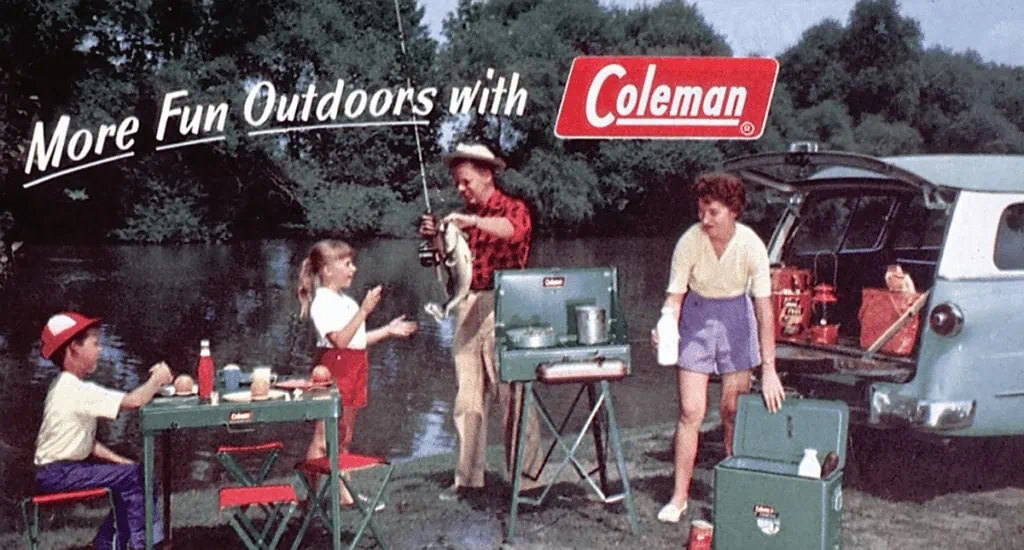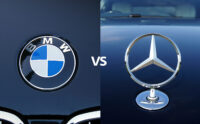How a Shift from Military Manufacturing to Outdoors Products Defined Coleman’s Brand
Coleman is synonymous with camping today, but its journey to recreational equipment market leader included attempts to launch waffle irons, toasters and air conditioners. It wasn’t until it developed an Army stove during World War II that Coleman began to evolve into a brand trusted by campers around the world.

You can neglect your Coleman propane lantern for years, for decades even. Yet when you pull it out of the camp crate or the dark corner of the garage where it has lain gathering dust, it illuminates almost without fail, bringing to light memories of summer family vacations spent exploring the great outdoors.
Few other brands have the same iconic association with quality and outdoor recreation as Coleman does. But before Coleman became synonymous with camping, the company struggled to brand itself in a meaningful way. Along the way, many attempts at new product launches ran aground, from waffle irons, coffee makers and toasters to air conditioners, pressure washers and even B-47 airplane parts for Boeing. Despite those failures, today Coleman is considered one of the world’s most trusted brands.
Coleman’s Evolution
Coleman’s journey to a trusted brand began more than 100 years ago, when W.C. Coleman was walking through the streets of Brockton, Alabama, after a day spent selling typewriters. He chanced upon a new gasoline lamp lighting a drugstore and saw potential in the strong, white flame that was so different from the smoky yellow light cast by that era’s standard kerosene lighters. The light was so bright, even with his poor eyesight W.C. could see the potential for that bright light to help people work, see and read better. He switched to selling lanterns and launched his own lamp with what became the Coleman Company. Today, this story is central to the brand’s lore.

As interest in Coleman’s lamp grew, he moved to Wichita, Kansas, where he set up company headquarters. The company continued growing through the 1920s (when, incidentally, he also served as mayor of Wichita) and pulled through the Great Depression by expanding into oil space heaters and gas furnaces. This period also marked its expansion into recreational camping equipment with the introduction of a portable stove and a lantern. These lanterns became indispensable during World War I, when the Allies requested wheat and corn from U.S. farmers. More than one million Coleman lanterns provided the portable light farmers needed to make their contribution to the war effort.
It wasn’t until World War II, however, that the company’s dedication to quality became something of legend: Tasked with developing a resilient compact stove able to meet key Army requirements—no larger than a milk bottle, able to operate at both 125 degrees and 60 degrees below and able to burn nearly any fuel—Coleman exceeded expectations. The Coleman Pocket Stove became essential at the battlefront, one described by famed war correspondent Ernie Pyle as one of the two most important pieces of noncombat equipment ever developed. (The other was the Jeep).
That stove was the precursor to the modern Coleman camp stove, a beloved piece of equipment used today at campsites around the world. Following World War II, its military manufacturing contracts were phased out, while at the same time camping became the hobby of the American summer as more people took the road in their newly-purchased cars during the post-war 1950s. As demand for Coleman’s stoves morphed, Coleman developed a recreational camping line of its stoves and lanterns, along with ice boxes and insulated jugs. America’s wild spaces were more accessible than ever before, and Coleman’s stoves provided a rugged and reliable outdoor kitchen as many stepped out into the backcountry for the first time.
Over the next two decades, Coleman continued to expand its camping line to eventually include tents, sleeping bags and heaters. Though the company continued to manufacture non-camping products such as furnaces and air conditioners, Coleman had hit on success with its camping gear—sales grew from $34 million in 1950 to $134 million in 1970.
This growth wasn’t driven solely by changing consumer demands, though. Coleman had evolved from producing a wide range of products to focusing primarily on recreational camping. In the process, its brand positioning evolved into that of a provider trusted for tough, high-quality gear for the recreational camper. Coleman had hit on an important tenant of brand building: focus. Though marketers often believe that narrowing their company’s offering results in lower profit, in reality, the opposite occurs.
Companies often add one product or service after another in hopes of attracting and keeping customers, boosting market share and increasing profitability,” Bain & Company partners Mark Gottfredson and Chuck Whitten said. “Many different functions—engineering, R&D, marketing, sales, customer service—push for new offerings or features. “At some point, however, product proliferation and the resulting complexity overwhelm the company’s systems. Costs rise. Quality declines. Salespeople get confused. Stock outs multiply. Meanwhile, many customers can’t find what they’re looking for or don’t know what to choose, and some depart for simpler pastures.”
“Product proliferation and the resulting complexity overwhelm the company’s systems. Costs rise. Quality declines. Salespeople get confused. Stock outs multiply. Meanwhile, many customers can’t find what they’re looking for or don’t know what to choose, and some depart for simpler pastures.”
Targeting A Niche Community
Car campers rely on Airstream, and diehard backpackers have Osprey or Patagonia, but Coleman found its niche with the outdoors recreationalist. By honing in on the messages and product traits that solve recreationalists’ biggest camping challenges, Coleman has built a highly-engaged community with strong brand equity around its products.
“Many brands mistakenly believe that the more community members they have, the better,” Scott Gerber wrote in Adweek. “But the most valuable communities are smaller, more exclusive and focus on building lifetime brand advocates by offering their members far more than the opportunity to buy.”
Today, Coleman continues to engage its community with its Outdoor Expert campaign, which aims to help its customers “discover stunning campsites, delicious recipes, and expert gear recommendations.” Through this campaign, Coleman breaks down myths about camping, offers advice on common camping questions such as how to build a cooking fire, and shares tips on topics such as how to pack a cooler or cohabitate with wildlife.

The company, while a ubiquitous brand in the outdoors known for reliability and durability, is also trying to reposition itself as more innovative. The brand is losing equity with a younger audience that doesn’t readily connect with Coleman’s nostalgic brand image.
Coleman leaders believe the company can be an “emotional brand” for people who remember using the gear growing up, said Mike Otterman, the global marketing VP at Coleman. Consumers often talk about their experiences rather than the product itself, and those experiences often incorporate “‘grandpa’s stove’ or lantern, Otterman added.
Emily Donahue, a Coleman product line manager, told GearJunkie that Coleman is working to combat that perception.
“Coleman is your ‘grandfather’s company’ to many people, with old lanterns and stoves,” Donahue said. “But that is dwindling off, and we’re trying to get people excited again.”
Over the last few years, the company has refreshed the look of nearly all of its products and has introduced hundreds of new products designed to mesh technology and the outdoors. Coleman has also started to more overtly target Millennials and Gen Z through social media, though much of the imagery is still nostalgia focused.
“Coleman is your ‘grandfather’s company’ to many people, with old lanterns and stoves. But that is dwindling off, and we’re trying to get people excited again.”
As those who grew up with the brand age, Coleman is spending its equity with younger consumers quickly. Coleman’s brand refresh is well-timed, but only time will tell whether it will win the hearts (and wallets) of the young audience it needs to survive.



